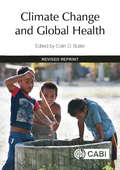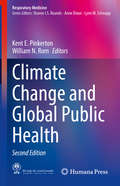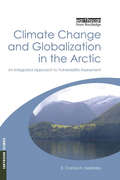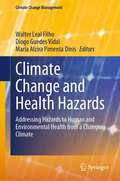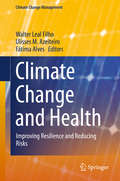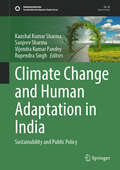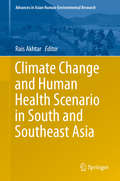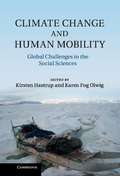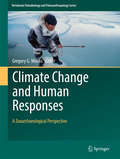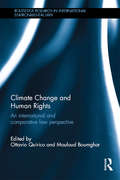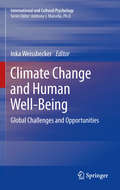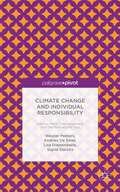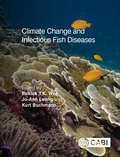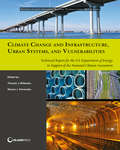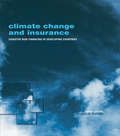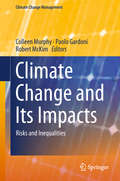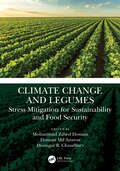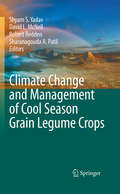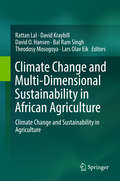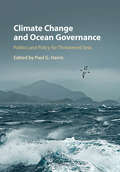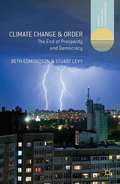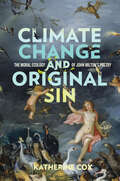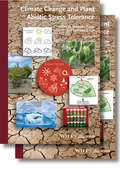- Table View
- List View
Climate Change and Global Health
by Professor Colin D. ButlerThere is increasing understanding, globally, that climate change will have profound and mostly harmful effects on human health. This authoritative book brings together international experts to describe both direct (such as heat waves) and indirect (such as vector-borne disease incidence) impacts of climate change, set in a broad, international, economic, political and environmental context. This unique book also expands on these issues to address a third category of potential longer-term impacts on global health: famine, population dislocation, and conflict. This lively yet scholarly resource explores these issues fully, linking them to health in urban and rural settings in developed and developing countries. The book finishes with a practical discussion of action that health professionals can yet take. Now with added chapter updating key changes affecting climate change and health through 2015, culminating with UN secretary general Ban Ki Moon's hopeful comment "What was once unthinkable is now unstoppable". Climate change, now clearly worsening, is triggering a powerful social and technological response. Will this response be sufficient to avert its potentially catastrophic "tertiary" health effects? Read a chapter for free.
Climate Change and Global Public Health: Air Pollution, Global Climate Change, And Wilderness (Respiratory Medicine #7)
by William N. Rom Kent E. PinkertonThis book is a guide to the research, findings, and discussions of US and international experts on climate change and respiratory health. Since the publication of the first edition, climate change has been increasingly acknowledged as being directly related to the prevalence and incidence of respiratory morbidity. Evidence is increasing that climate change does drive respiratory disease onset and exacerbation as a result of increased ambient and indoor air pollution, desertification, heat stress, wildfires, and the geographic and temporal spread of pollens, molds and infectious agents. This second edition is fully updated to include the latest research by international experts on topics such as heat waves causing critical care-related diseases, climate-driven air pollution increases, and high-level ozone and ozone exposure linked to idiopathic pulmonary fibrosis, lung cancer, and acute lower respiratory infection. Seven new chapters have also been added on extreme weather and agricultural safety in California; desert dust effects on lung health; climate policy and the EPA; California's integrated approach to air quality and climate change; integrating climate change, the environment, and sustainability themes into professional health science courses; and the role of the physician as climate advocate. This is an ideal guide for all pulmonologists and health professionals treating patients with pulmonary disease.
Climate Change and Globalization in the Arctic: An Integrated Approach to Vulnerability Assessment (Earthscan Climate)
by E. Carina KeskitaloClimate change vulnerability assessment is a rapidly developing field. However, despite the fact that such major trends as globalization and the changing characteristics of the political and economic governance systems are crucial in shaping a community?s capacity to adapt to climate change, these trends are seldom included in assessments. This book addresses this shortcoming by developing a framework for qualitative vulnerability assessment in ?multiple impact? studies (of climate change and globalization) and applying this framework to several cases of renewable natural resource use. The book draws upon case studies of forestry and fishing - two of the largest sectors that rely on renewable natural resources - and reindeer herding in the European North. The study represents a bottom-up view, originating with the stakeholders themselves, of the degree to which stakeholders find adaptation to climate change possible and how they evaluate it in relation to their other concerns, notably economic and political ones. Moreover, the approach and research results include features that could be broadly generalized to other geographic areas or sectors characterized by renewable natural resource use.
Climate Change and Health Hazards: Addressing Hazards to Human and Environmental Health from a Changing Climate (Climate Change Management)
by Walter Leal Filho Diogo Guedes Vidal Maria Alzira Pimenta DinisThis book contains a set of papers which explore the links among climate change, health, and hazards and demonstrate how they interact. It emphasizes the urgency of immediate and more ambitious action to address climate risks. According to the Intergovernmental Panel on Climate Change (IPCC), human-induced climate change is known to be causing dangerous and widespread disruptions in nature and is affecting the lives of billions of people around the world, despite efforts to reduce the risks. Climate change is also negatively influencing health and is mounting threat to our wellbeing and a healthy planet. The world is also facing significant climate hazards over the next two decades, with global warming expected to soon reach 1.5°C. Even temporarily exceeding this warming level will result in additional severe impacts, some of which may be irreversible. There is therefore a perceived need for publications which may foster a greater understanding of how climate change connects to human health and the role played by hazards in this context. It is against this background that this book is being prepared.
Climate Change and Health: Improving Resilience and Reducing Risks (Climate Change Management)
by Walter Leal Filho Ulisses M. Azeiteiro Fátima AlvesA major objective of this volume is to create and share knowledge about the socio-economic, political and cultural dimensions of climate change. The authors analyze the effects of climate change on the social and environmental determinants of the health and well-being of communities (i. e. poverty, clean air, safe drinking water, food supplies) and on extreme events such as floods and hurricanes. The book covers topics such as the social and political dimensions of the ebola response, inequalities in urban migrant communities, as well as water-related health effects of climate change. The contributors recommend political and social-cultural strategies for mitigate, adapt and prevent the impacts of climate change to human and environmental health. The book will be of interest to scholars and practitioners interested in new methods and tools to reduce risks and to increase health resilience to climate change.
Climate Change and Human Adaptation in India: Sustainability and Public Policy (Sustainable Development Goals Series)
by Sanjeev Sharma Kaushal Kumar Sharma Vijendra Kumar Pandey Rupendra SinghThis contributed volume presents an attempt to understand climatic variability and induced risk to livelihood of communities and to offer insights on how catastrophic conditions and crises can be mitigated through public policy interventions. The case studies herein offer insights into different spheres and domains affected by climate change and present models of adaptation possibilities. The book is divided into three thematic sections. The first contains chapters that deal with assessing the effects of climate change. The second section offers perspectives on adaptation and governance, vulnerability in the context of sustainable livelihoods. The third and last section looks at Policy and Governance, with respect to climatic change adaptation and mitigations. The lessons contained in this volume are useful to a wide audience including research scholars, students, policymakers, and planners.
Climate Change and Human Health Scenario in South and Southeast Asia (Advances in Asian Human-Environmental Research)
by Rais AkhtarThis book is the first to present a regional analysis of climate change and human health, focusing on geographically and socio-economically distinct countries of South and Southeast Asia. It has a major focus on India, Indonesia, Bangladesh, Malaysia, Thailand, Nepal and Taiwan. Climate change is a significant and emerging threat to human health. lt represents a range of environmental hazards and will affect populations in both the developed and developing countries. In particular, it affects the regions where the current burden of climate-sensitive diseases are high, which is the case in South and Southeast Asian countries.
Climate Change and Human Mobility
by Kirsten Hastrup Karen Fog Olwig'The greatest single impact of climate change could be on human migration', stated the Intergovernmental Panel on Climate Change (IPCC) in 1990. Since then there has been considerable concern about the large-scale population movements that might take place because of climate change. This book examines emerging patterns of human mobility in relation to climate change, drawing on a multidisciplinary approach, including anthropology and geography. It addresses both larger, general questions and concrete local cases, where the link between climate change and human mobility is manifest and demands attention – empirically, analytically and conceptually. Among the cases explored are both historical and contemporary instances of migration in response to climate change, and together they illustrate the necessity of analyzing new patterns of movement, historic cultural images and regulation practices in the wake of new global processes.
Climate Change and Human Responses: A Zooarchaeological Perspective (Vertebrate Paleobiology and Paleoanthropology)
by Gregory G. MonksThis book contributes to the current discussion on climate change by presenting selected studies on the ways in which past human groups responded to climatic and environmental change. In particular, the chapters show how these responses are seen in the animal remains that people left behind in their occupation sites. Many of these bones represent food remains, so the environments in which these animals lived can be identified and human use of those environments can be understood. In the case of climatic change resulting in environmental change, these animal remains can indicate that a change has occurred, in climate, environment and human adaptation, and can also indicate the specific details of those changes.
Climate Change and Human Rights: An International and Comparative Law Perspective (Routledge Research in International Environmental Law)
by Ottavio Quirico Mouloud BoumgharDo anthropogenic greenhouse gas emissions affect human rights? Should fundamental rights constrain climate policies? Scientific evidence demonstrates that anthropogenic greenhouse gas emissions contribute to increasing atmospheric temperatures, soon passing the compromising threshold of 2° C. Consequences such as Typhoon Haiyan prove that climate alteration has the potential to significantly impair basic human needs. Although the United Nations Framework Convention on Climate Change and human rights regulatory regimes have so far proceeded separately, awareness is arising about their reciprocal implications. Based on tripartite fundamental obligations, this volume explores the relationship between climate change and interdependent human rights, through the lens of an international and comparative perspective. Along the lines of the metaphor of the ‘wall’, the research ultimately investigates the possibility of overcoming the divide between universal rights and climate change, and underlying barriers. This book aims to be a useful resource not only for practitioners, policymakers, academics, and students in international, comparative, environmental law and politics and human rights, but also for the wider public.
Climate Change and Human Well-Being: Global Challenges and Opportunities (International and Cultural Psychology)
by Inka WeissbeckerClimate change is increasing the severity of disasters and adverse weather conditions worldwide, with particularly devastating effects on developing countries and on individuals with lower resources. Climate change is likely to impact mental health and psychosocial well-being via multiple pathways, leading to new challenges. Direct effects such as gradual environmental changes, higher temperatures, and natural disasters, are likely to lead to more indirect consequences such as social and economic stressors, population displacement, and conflict. Climate change, largely the product of industrialized nations, is projected to magnify existing inequalities and to impact the most vulnerable, including those with low resources, individuals living in developing countries and specific populations such as women, children and those with pre-existing disabilities. This book outlines areas of impact on human well being, consider specific populations, and shed light on mitigating the impact of climate change. Recommendations discuss ways of strengthening community resilience, building on local capacities, responding to humanitarian crises, as well as conducting research and evaluation projects in diverse settings.
Climate Change and Individual Responsibility: Agency, Moral Disengagement and the Motivational Gap
by Sigrid Sterckx Wouter Peeters Andries De Smet Lisa DiependaeleThis book discusses the agency and responsibility of individuals in climate change, and argues that these are underemphasized, enabling individuals to maintain their consumptive lifestyles without having to accept moral responsibility for their luxury emissions.
Climate Change and Infectious Fish Diseases
by Patrick T.K. Woo Jo-Ann Leong Kurt BuchmannClimate change with global warming is not disputed by the vast majority of scientists and the aquatic system is most affected. A global rise in water temperature and acidification of the aquatic environment will continue even if we can significantly reduce the current output of the two most important greenhouse gasses (carbon dioxide and methane). These and other environmental changes will affect fish health which includes infectious pathogens. This important new text is the second volume on climate change and fish health. It covers changes to the freshwater ecosystem and their current and expected effects on selected infectious diseases of fish. The book represents contributions by over 50 experts from 18 countries. Comprehensive and thought-provoking, the book details abiotic and biotic environmental changes in temperate and tropical freshwater ecosystems, sequestrations of atmospheric carbon dioxide and effects on infectious diseases (12 microbial and 10 parasitic) in economically important fish in tropical, subtropical and temperate waters. The text is key reading for fish disease scientists, aquatic ecologists, fish health consultants, veterinarians, policy makers and all who are interested in fish health and the environment.
Climate Change and Infrastructure, Urban Systems, and Vulnerabilities: Technical Report for the U.S. Department of Energy in Support of the National Climate Assessment (NCA Regional Input Reports)
by Thomas J. Wilbanks Steven FernandezHurricane Irene ruptured a Baltimore sewer main, resulting in 100 million gallons of raw sewage flooding the local watershed. Levee failures during Hurricane Katrina resulted in massive flooding which did not recede for months. With temperatures becoming more extreme, and storms increasing in magnitude, American infrastructure and risk-management policies require close examination in order to decrease the damage wrought by natural disasters. Climate Change and Infrastructure, Urban Systems, and Vulnerabilities addresses these needs by examining how climate change affects urban buildings and communities, and determining which regions are the most vulnerable to environmental disaster. It looks at key elements of urban systems, including transportation, communication, drainage, and energy, in order to better understand the damages caused by climate change and extreme weather. How can urban systems become more resilient? How can citizens protect their cities from damage, and more easily rebound from destructive storms? This report not only breaks new ground as a component of climate change vulnerability and impact assessments but also highlights critical research gaps in the material. Implications of climate change are examined by assessing historical experience as well as simulating future conditions. Developed to inform the 3rd National Climate Assessment, and a landmark study in terms of its breadth and depth of coverage and conducted under the auspices of the U. S. Department of Energy, Climate Change and Infrastructure, Urban Systems, and Vulnerabilities examines the known effects and relationships of climate change variables on American infrastructure and risk-management policies. Its rich science and case studies will enable policymakers, urban planners, and stakeholders to develop a long-term, self-sustained assessment capacity and more effective risk-management strategies.
Climate Change and Insect Biodiversity: Challenges and Implications
by Muhammad Bilal Tahir Habib Ali Youming HouThis up-to-date reference book discusses the effects of climate change on the biodiversity of insect pests. The changing climate and agricultural intensification practices impact negatively on insect biodiversity. The book explains the significance of insect pests for evaluating climatic impacts on a wide range of ecological systems. It covers the effect of climate change on pollinators and household and agricultural insect pests. It explains how climate-smart agriculture can enhance productivity and food security.FEATURES Reviews the effects of climate change on plant-insect interactions Includes topics such as insect biodiversity informatics and conservation Discusses food security, pest management, and beneficial and social insects Covers topics such as precision agriculture and climate-smart agriculture Provides insights on the relation between agriculture intensification and insect biodiversity This book is meant for scientists, researchers, and students working in the fields of agriculture, entomology, ecology, plant science, environmental biology, and biotechnology.
Climate Change and Insurance: Disaster Risk Financing in Developing Countries
by Eugene N. GurenkoClimate change brings about a new set of major economic risks arising from changing weather patterns, extreme weather events and rising sea levels. Most at risk are developing countries who, despite considerable post-disaster donor aid, have been bearing the major brunt of disaster-related losses. One adaptation solution that is rapidly gaining the support of countries and international donors is a risk transfer to the global reinsurance and capital markets. This volume, a special issue of the journal Climate Policy, explores the role that insurance-based mechanisms can play in helping developing countries prepare for climate change. It offers a unique and comprehensive perspective on the potential role of insurance solutions in global adaptation to climate change and attempts to engender debate on the role of insurance in reducing global emissions and encouraging climate-friendly corporate behaviour.
Climate Change and Its Impacts: Risks and Inequalities (Climate Change Management)
by Colleen Murphy Paolo Gardoni Robert McKimResponding to a need for a deeper and more nuanced understanding of the consequences of climate change, this book brings experts in climate science, engineering, urban planning, and conservation biology into conversation with scholars in law, geography, anthropology and ethics. It provides insights into how climate change is conceptualized in different fields. The book also aims to contribute to developing successful and multifaceted strategies that promote global, intergenerational and environmental justice. Among the topics addressed are the effects of climate change on the likelihood and magnitude of natural hazards, an assessment of civil infrastructure vulnerabilities, resilience assessment for coastal communities, an ethical framework to evaluate behavior that contributes to climate change, as well as policies and cultural shifts that might help humanity to respond adequately to climate change.
Climate Change and Justice
by Jeremy MossAchieving climate justice is increasingly recognized as one of the key problems associated with climate change, helping us to determine how good or bad the effects of climate change are, and whether any harms are fairly distributed. The numerous and complex issues which climate change involves underline the need for a normative framework that allows us both to assess the dangers that we face and to create a just distribution of the costs of action. This collection of original essays by leading scholars sheds new light on the key problems of climate justice, offering innovative treatments of a range of issues including international environmental institutions, geoengineering, carbon budgets, and the impact on future generations. It will be a valuable resource for researchers and upper-level students of ethics, environmental studies, and political philosophy.
Climate Change and Legumes: Stress Mitigation for Sustainability and Food Security
by Doongar R. Chaudhary Hossain Anawar Mohammad Zabed HossainGlobal climate change has created unprecedented challenges for human civilization due to its widespread adverse consequences, including a reduction in crop yield and threatening food security across the globe. Among the crop plants, legumes have great potential for ameliorating global warming since they can reduce carbon emissions by lowering reliance on the application of chemical fertilizers, by increasing nitrification and carbon sequestration in soil, and by providing protein-rich diets to both humans and livestock. This book identifies the extent of climate-induced stresses on legume plants and focuses on achieving food security through sustainable agricultural practices.This book compiles recent research findings and reviews on climate-related problems, the potential of legumes in ameliorating the impacts of climate change, as well as better management of agricultural land and practices for achieving environmental sustainability and food security.This book will serve as guidelines for scientists, agricultural practitioners, and policymakers working to achieve food security and better management of climate-induced stresses in agricultural interventions. It will also be useful as a reference book for researchers and students of both graduate and postgraduate levels. Furthermore, this book will provide enhanced knowledge about the mechanisms of yield and stress tolerance of legumes as well as developing climate-smart crops and improving cropping systems for a sustainable environment and food security. Features of the book Reviews trends of global climate change and its consequences for food security across the continents Identifies the challenges and scopes of cultivating legumes in achieving food security in the context of global climate change Focuses on the improvements of legume production through conservation approaches in agricultural practices and modern techniques, including omics-based breeding, biotechnology, genetic engineering, and rhizobium technology Discusses the sustainable amelioration options for soils affected by climate-induced stresses Cites examples of applications of rhizobium technologies in reducing greenhouse gas emission Describes pathways associated with yield, resistance, and tolerance of legumes to climate-induced stresses
Climate Change and Management of Cool Season Grain Legume Crops
by Shyam Singh Yadav Robert Redden David L. Mcneil Sharanagouda A. PatilThis book covers all aspect of legume production management technologies, plant ecological response, nutrients management, biological nitrogen fixation, molecular approaches, potential cultivars, biodiversity management under climate change. Also covered are various aspects of legume management under climate change such as, production management technology, ecology & adaptation, diseases, and international trade; physiology and crops response to nutrients, drought, salinity, and water use efficiency; Biodiversity management, molecular approaches and biological Nitrogen fixation; climate change and strategies. This book presents the most comprehensive and up to date review of research on different cool season grain legume crops, nutrients management, biotic and abiotic stresses management, agronomical approaches for drought management, salinity, drought, weed management and water use efficiency, impact on international trade around the world.
Climate Change and Multi-Dimensional Sustainability in African Agriculture: Climate Change and Sustainability in Agriculture
by Rattan Lal Bal Ram Singh David Kraybill David O. Hansen Lars Olav Eik Theodosy MosogoyaThis 35-chapter book is based on several oral and poster presentations including both invited and contributory chapters. The book is thematically based on four pillars of sustainability, with focus on sub-Saharan Africa (SSA): Environment, Economic, Social and Institutional. The environmental sustainability, which determines economic and social/institutional sustainability, refers to the rate of use of natural resources (soil, water, landscape, vegetation) which can be continued indefinitely without degrading their quality, productivity and ecosystem services for different ecoregions of SSA. This book will help achieve the Sustainable Development Goals of the U. N. in SSA. Therefore, the book is of interest to agriculturalists, economists, social scientists, policy makers, extension agents, and development/bilateral organizations. Basic principles explained in the book can be pertinent to all development organizations.
Climate Change and Ocean Governance: Politics and Policy for Threatened Seas
by Paul G. HarrisClimate Change and Ocean Governance brings together authors from political science and cognate disciplines to examine the political and policy dimensions of climate change for our oceans. The environmental, social and economic consequences of oceanic change present tremendous challenges for governments and other actors. New and innovative policies for governing oceans and seas - and for managing vital marine resources - have never been more important. Existing national and international institutions for marine governance that were created when oceanic conditions were relatively static may not be adequate for a future characterized by continuous oceanic change. Responses to oceanic change will result in winners and losers, and thus will involve politics in all its manifestations. This book reveals the unavoidable connections between climate change, the oceans, and questions of governance. It provides valuable lessons for researchers, policymakers and activists concerned about governing oceanic change into the future.
Climate Change and Order
by Beth Edmondson Stuart LevyBeth Edmondson and Stuart Levy examine why it is so difficult for the international community to respond to global climate change. In doing so, they analyse and explain some of the strategies that might ultimately provide the foundations for appropriate responses.
Climate Change and Original Sin: The Moral Ecology of John Milton's Poetry (Under the Sign of Nature)
by Katherine CoxPrior to the Enlightenment era, how was the human-climate relationship conceived? Focusing on the most recent epoch in which belief in an animate environment still widely prevailed, Climate Change and Original Sin argues that an ecologically inflected moral system assumed that humanity bore responsibility for climate corruption and volatility.The environmental problem initiated by original sin is not only that humans alienated themselves from nature but also that satanic powers invaded the world and corrupted its elements—particularly the air. Milton shared with contemporaries the widespread view that storms and earthquakes represented the work of fearsome spiritual agents licensed to inflict misery on humans as penalty for sin. Katherine Cox’s work discerns in Paradise Lost an ecological fall distinct from, yet concurrent with, the human fall. In examining Milton’s evolving representations of the climate, this book also traces the gradual development of ideas about the atmosphere during the seventeenth century—a change in the intellectual climate driven by experimental activity and heralding an ecologically devastating shift in Western attitudes toward the air.
Climate Change and Plant Abiotic Stress Tolerance
by Narendra Tuteja Sarvajeet S. GillIn this ready reference, a global team of experts comprehensively cover molecular and cell biology-based approaches to the impact of increasing global temperatures on crop productivity. The work is divided into four parts. Following an introduction to the general challenges for agriculture around the globe due to climate change, part two discusses how the resulting increase of abiotic stress factors can be dealt with. The third part then outlines the different strategies and approaches to address the challenge of climate change, and the whole is rounded off by a number of specific examples of improvements to crop productivity. With its forward-looking focus on solutions, this book is an indispensable help for the agro-industry, policy makers and academia.
